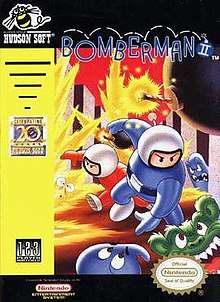Bomberman II
Bomberman II (ボンバーマンII, Bonbāman Tsū) is a video game developed and published by Hudson Soft and released for the Family Computer/Nintendo Entertainment System in 1991. The game was titled Dynablaster in Europe.
| Bomberman II | |
|---|---|
 North American cover art | |
| Developer(s) | Hudson Soft |
| Publisher(s) | Hudson Soft |
| Producer(s) | Shigeki Fujiwara |
| Designer(s) | Hitoshi Okuno |
| Programmer(s) | Yasuhiro Kosaka |
| Artist(s) | Mika Sasaki |
| Composer(s) | Jun Chikuma |
| Series | Bomberman |
| Platform(s) | Family Computer/NES |
| Release | |
| Genre(s) | Puzzle, maze |
| Mode(s) | Single-player, multiplayer |
Story
A Bomberman named White Bomberman is framed for terrible crimes by Black Bomberman. After being accused of robbing a bank, White Bomberman is thrown in jail. Bomberman's mission is to escape his prison cell and bring Black Bomberman to justice.
Gameplay
The game follows the classic Bomberman formula: you are in a room full of blocks and enemies and Bomberman must plant bombs to destroy the blocks and enemies. Several blocks contain power-ups (such as blast radius increasers or fuse shorteners), and one in each level contains a door, which takes Bomberman to the next level.
Passwords are given after a game over, recording the level, number of bombs, and strength of bombs. These passwords can be entered when the game starts allowing the player to continue where he or she left off.
New to the series are the multi-player modes. Vs Mode is a two-player mode, while Battle Mode is a three-player mode. The objective is to kill the opposing Bomberman by planting bombs. An NES Four Score is required to play the three-player mode.
_gameplay.png)
References
- "Hudson - Action game (archive)". Hudson Soft. Hudson. Archived from the original on 6 February 1997. Retrieved 31 October 2014.CS1 maint: BOT: original-url status unknown (link)
- Nintendo staff. "NES Games" (PDF). Nintendo. Archived from the original (PDF) on December 21, 2010. Retrieved September 24, 2011.